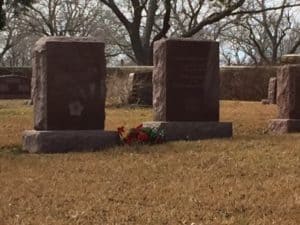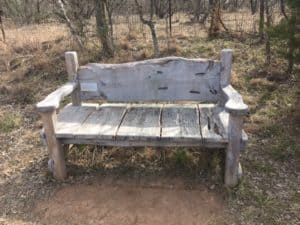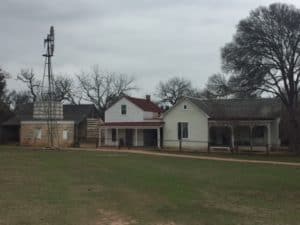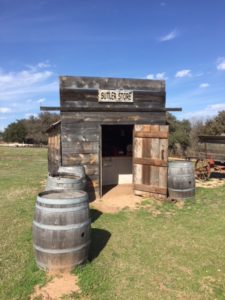Five weeks in Fredericksburg wasn’t enough with so many great things to do and see. Not even close. Still, I feel like I put a dent in the list. Today I share my adventures in Fredericksburg. Plus, there is the inevitable lists of the things I didn’t do and the things I’ll be sure to do next time I’m in the area.
Lady Bird Johnson Municipal Park

Solstice waiting on the three-plank bridge for me to get down the rock steps so she can jump into the water.
This was one of my favorite adventures. I enjoyed it so much, I returned seven times. And that’s saying a lot because each time involved a 28-mile drive, round-trip. This municipal park is huge with a beautiful 18-hole golf course, swimming pool, tennis courts, fishing, RV camping area, picnic area and a nature trail. I drove the whole thing to see it but the Nature Trail was the reason it made the priority list of Fredericksburg adventures.
I mentioned the Nature Trail to several people and the most common response I got was, “You mean the one in Austin? Lady Bird Johnson Wildflower Center?” Last week in my introduction to the area, I talked about the confusion with so many things named Johnson. This is an example.
It is an interpretive trail so the first time Solstice and I went, I picked up the map and brochure. There were 14 stops along the one-mile loop. It was easy terrain but still worth being cautious over the short rocky crag portion, the 3-plank river bridge and on the natural stairs.
The bird blind was a fun stop because volunteers who maintain the trail fill feeders so lots of bird gather in the area. I was also interested in the butterfly stop. But it, like most of the stops, was still fairly dormant. We missed seeing Hill Country at its best by just a few weeks. On the last visit, I saw a lone butterfly.
LBJ Stuff
I’m going to do my best here to untangle the Johnson-named stuff. Let’s start in Stonewall, Texas, the place where the 36th US President was born, lived, died and was buried. While Stonewall is about 17 miles from Fredericksburg, it was only seven miles from my campground. Because it had a Nature Trail and was so close, I made four trips.

Johnson Family Cemetery where generations of Johnson lie. The largest headstones are Lyndon Baines and Lady Bird Johnson’s.
For all intents and purposes, when you go to the Stonewall site, you are visiting both the LBJ National Historic Park as well as the LBJ State Park. The National Park includes his ranch, the self-guided drive around his property, Junction School (his first school), the Johnson Family Cemetery (both LBJ and Lady Bird rest there) and other buildings.
To go on the self-driving tour, however, you stop at the LBJ State Park Visitor’s Center for your free driving permit. The State Park includes the Nature Trail, the Sauer-Beckmann Living History Farm, the Visitor’s Center and Exhibit Hall
And overall, it really isn’t confusing except for the fact that both are publicized separately, and individual things within each are publicized separately. The Junction School, for example, has its own brochure. As does the Sauer-Beckmann Farm. Can you see how that would be confusing to a visitor?
Okay, I’m going to stop beating that dead horse and let that frustration go. Mostly. let me tell you how much fun the place was. And it was almost entirely free. One of the awesome surprises of RV life I have discovered.
To tour the LBJ National Park, after you pick up the driving permit, just follow the signs. The single-lane road is a 12-mile tour through the Johnson ranch. There are pull outs with information signage along the route. There are buildings and places you can visit like the Junction School and his Show Barn. The barn he had specially built so, when driving his guests around the property, he could drive down the center of the barn to show off his livestock without having to get out of his Cadillac convertible.
Finally, the drive takes you to the family home. The Texas White House, as the media dubbed it because of how much time he spent here during his presidency and how many important people visited. A guided tour of their residence is the only experience you have to pay for, if you want to do it. It’s well worth the $3 charge.
Even though LBJ died in 1973 (on the tour you’ll see the exact place he took his last breath from a heart attack) Lady Bird lived in the house on a part-time basis until her death in 2007. There were limited tours during her lifetime but it was only in 2011 that the entire first floor of the house was open for the public to tour.
I had lots of favorites on the tour. Photography wasn’t allowed so I’ll share one story that moved me. The story of November 22, 1963, told as we stood in the Johnson kitchen. The Vice President and Lady Bird were going to have the Kennedys over after their visit to Dallas so the house was hustling and bustling in preparation. A small black and white television was on in the kitchen.
Because the house is preserved for the period and because the volunteer tour guide painted such a vivid picture and because the black and white television is still there, you really feel what it must’ve been like that day.
You know what happened next.
LBJ’s staff stood riveted before the television as Walter Cronkite came on in that famous moment where he announces that President Kennedy had died. In a shaky voice, Cronkite adds Vice President Johnson left the hospital but there was no word where he proceeded, presumably to take the oath of office.
Not long after, Secret Service came into the kitchen and announced, “You are now in the home of the President of the United States.”
Outside the house, you can see the plane LBJ affectionately dubbed Air Force One-Half. Air Force One could not land at the ranch because the runway wasn’t long enough. Instead, it would land at nearby Fredericksburg, then LBJ would hop on the 13-passenger JetStar to bring him to his beloved ranch. The plane was rescued in 2009 from a government “bone yard” and refurbished to its original glory. You walk up the stairs and look into both the cockpit and the body of the plane but they are protected by glass so you don’t actually go into it.
The LBJ State Park was my favorite of the LBJ places because of the Nature Trail and the Sauer-Beckmann Living History Farm.
Walk three-quarters of mile along the interpretive trail and you come to the farm. You can also drive to the farm which most people did. I don’t know why but we rarely crossed paths with people on the Nature Trail. The farm, interestingly enough, really has nothing to do with LBJ or the Johnson family except geography. It was a neighboring farm.
 The Sauer family with their 10 children settled the land in 1869. (A fun side note is that one of those children grew up and served as the midwife at LBJ’s birth in 1908.) In 1900, the Beckmann family acquired the property. And in 1966, it was sold to the Texas Parks and Wildlife Department. After archaeological surveying and restoration, the farm opened to the public in 1975.
The Sauer family with their 10 children settled the land in 1869. (A fun side note is that one of those children grew up and served as the midwife at LBJ’s birth in 1908.) In 1900, the Beckmann family acquired the property. And in 1966, it was sold to the Texas Parks and Wildlife Department. After archaeological surveying and restoration, the farm opened to the public in 1975.
What makes it so unique?
It’s a place where time stood still. The farm is a working farm of the early part of last century. Everything about it operates as if it were 1915. Staffed entirely by volunteers, every day they do the day-to-day work of what a farm back then would do. Dressed in period attire, they use 100-year old farming instruments to tend the
garden and chop wood They feed chickens, churn butter, can meat and vegetables, sheer sheep, cook only what they have grown or butchered over a wood stove.
It really is a step back in time. Visitors get to walk through the farm, the buildings and talk to the volunteers living the life. Each and every day they put in a hard day’s work.
On my first visit, the men were butchering something (sorry, this wannabe vegetarian couldn’t get too close). They told me it took several days to complete the task. I arrived near the end of the day and found them scrubbing the wooden butchering table with homemade lye soap. On my second visit, about a week later, the meat was being turned into sausage.
Sausage was a common way to process and preserve meat back then because, of course, there as no refrigeration. On a later visit, I stuck my head into the smokehouse and saw the results of their labor hanging.
On the last visit, a calf had been born just four hours earlier. And inside the kitchen, the women were looking through a 1915 mail order catalogue to see what women of the day did for makeup. Turns out rouge (called blush today) made with arsenic was guaranteed to “plump the skin.”
In Johnson City, about 20 miles east of Stonewall—so 30 miles east of Fredericksburg—the National Historical Park also runs the Johnson City District historical area which includes LBJ’s Boyhood Home and the Johnson Settlement. The Johnson Settlement is a nice walking tour with old buildings from other Johnsons.

Ranger Johnson welcoming us on the spot where LBJ announced his candidacy for the US House of Representatives.
LBJ’s Boyhood Home was a treat. LBJ lived in the home from the ages of 5 until he married at 26. The guided tour was free and conducted by a Ranger of the National Park Service. Our guide, Ranger John, was fantastic. Not only was he knowledgeable, but he was a bit of an actor.
To give us a taste of how persuasive LBJ could be, he chose a woman from New Hampshire to represent her home state. And then he went into LBJ mode and soon had the woman agreeing she would vote yes on the legislation LBJ was trying to get passed.
The highlight for me was at the very beginning, before we even went into the house. Ranger John stood on the porch, in the same spot, where in March 1937 LBJ declared his intention to run for the US House of Representatives.
Fort Martin Scott
The military fort was established in late 1848 and was the first Army post on the western frontier. Men assigned to fort escorted travelers through the area and kept residents safe from the Indians. The complex was 21 buildings which included officers’ quarters, enlisted men’s bunkhouses, a small store, a hospital, laundry building, cooking building The and a jail.
You can walk the fort along a half mile gravel path to see the six standing buildings and the foundations of the others. During their regular hours, the buildings are open to walk through and view artifacts of the era. But if you just want to walk the outside path, see the outside of the buildings and read the information signs, you can go anytime. It’s a great place for a quick dog walk. We went three times.
The city of Fredericksburg owns and operates the fort. There is no charge but they gladly accept donations. The stocked general store is fun. But my favorite was the watch-guard and jail building. It included a room for the man on duty, a game room and three jail cells.
The jail cells were tiny. Quill (my Oliver trailer) is a mansion compared to those cells. In addition to confinement, punishments included wearing a barrel (for drunkards), being hung by the thumbs, loss of rank, fines or dishonorable discharge.
Pioneer Museum
The Pioneer Museum takes up a city block in downtown Fredericksburg. The “pioneer” period is fairly liberal for the purposes of this museum, representing about 1855 up 1920, depending which building you are in. It’s made up of 10 buildings you tour for the $7.50 admission fee. Four of the buildings are in their original location. The rest were bought and moved to join the museum’s other buildings.
If one had limited time in Fredericksburg, this would be a good choice because of the variety. It starts with the 12-minute video to give the history of the area, then you move through each building. The buildings include a Sunday house, a one-room school house, a pioneer homestead with the house and barn and smokehouse, a bathhouse, a cabin and a few homes.
The barn is interesting because it’s filled with period tools and machinery. I particularly liked the bathhouse and barbershop. I loved all the details: the items for a shave, the shoe shine seat.
Texas Wine Country
Like in the Walla Walla Valley, Hill Country has become home to a plethora of vineyards. There are so many along US highway 290 one company has a fleet of shuttle buses that take people up and down the highway from one tasting room to the next.
I went to two. If you are in Fredericksburg, go the Messina Hof Winery. It is a lovely setting, with knowledgeable staff and, most importantly, good wine.
What I Didn’t Do
If you do a “things to do in Fredericksburg” internet search, the number one thing on most lists is the National Museum of the Pacific War. It’s so big that when you purchase your $15 admission ticket, it’s actually valid for two days. WWII vets are free.
But for some reason, it just didn’t call to me. Maybe it was knowing so much was free, I didn’t want to spend $15. But, really, I think it was two days inside isn’t nearly as appealing to me as a nature walk where I can take my dog.
To be fair though, many people told me it was a great museum and I don’t doubt it. It just didn’t make my priority list.
Things on the List for Next Time I’m in Fredericksburg
- Spend more time in the downtown area just wandering. It’s a neat area with lots of fun shops but because my campground was outside of town, I didn’t make it in much.
- Go on the self-guided Walking Tour of the Historic District. I discovered walking tours in Walla Walla and just loved them. The ones in downtown areas generally aren’t good for dogs (or my dog anyway) because of all the people. So while this was on my priority list, I just kept putting it off until I ran out of time.
- Explore other Hill Country communities. One day, errands took me to two nearby towns. While I was destination-focused, as I drove through Boerne looking for a particular bank, I thought I wish I had more time. This town seems as nifty as Fredericksburg. Included on that list is also the town, Luchenbach, population 3. And, yes, it’s the same Luchenbach, Texas made famous by the Waylon Jennings country song.
- Each evening three million bats emerge from a 920-foot no-longer-used railroad tunnel at Old Tunnel State Park. The “black tornado” overhead (called that because of their upward spiral motion to gain altitude) kind of freaked me out. But intrigued me too. And my rule is to embrace fear and try new things. So, it made the list but, it turns out that bats, like other birds, migrate. The nightly bat performance is only May through October. Dang. It was a disappointment.
- Hill Country wild flowers are famous. The photos are like ground rainbows. Amazing. As I was leaving the area in the second week in March, I saw the first buds starting to open. I missed the full glory of the season by just a few weeks.
I have a lot of reasons to make it back to the area. But before we wrap up my adventures in Fredericksburg, I have one final one to share. Join me next week for that story. I’ll give you a hint. An outhouse plays a prominent role in the tale.
Links to Referenced SSL Blog Posts Above:
- Fredericksburg in Texas Hill Country
- The Road Dog: Introducing Solstice
- 6 Most Surprising Things About RV Life
- Introducing My New Oliver Travel Trailer
- Two Months in Walla Walla, Part I
- Two Months in Walla Walla, Part II

















As always I loved the history. I remember my 4th grade teacher being called into the hall by the principal. When she came back into the classroom she was crying and told the class that JFK died. A few days later my brother was born and named John Fitzgerald. I see Solstice is able to walk 3 miles now … maybe the arthritis is improving with all the walking. Love, Marie